|
|
|
|
|
|
|
Achi-Kochi Japan
Showing many places to visit and foods to eat in Japan
|
|
|
|
|
|
|
|
|
|
|
|
|
Japan
> Chugoku region
> Miya-jima ( Itsuku-shima )
|
|
|
|
|
|
|
Miya-jima ( Itsuku-shima )
Hatsukaichi, Hiroshima, Chugoku
( Achi-Kochi Japan )
|
|
|
|
|
|
|
|
|
|
|
|
|
( "Achi-Kochi" in Japanese means "Here and there" in English. )
Miya-jima ( Itsuku-shima )
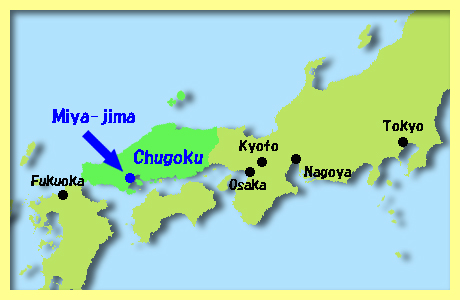
Miya-jima ( or Itsuku-shima - above ) is an island, located off Hatsukaichi City, Hiroshima Prefecture, Chugoku Region. Though it is an small island where less than 2,000 people live, more than three million people land on the island every year mainly to visit Itsuku-shima Jinja shrine, which is one of UNESCO World Heritage Sites as well as one of designated National Treasures of Japan.
|
|
Itsuku-shima Jinja shrine
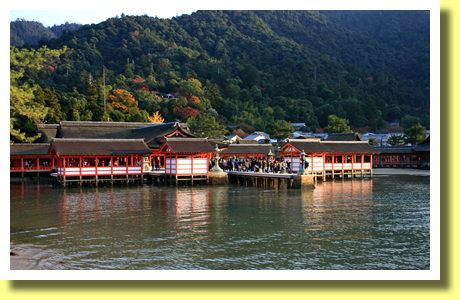
Itsuku-shima Jinja shrine ( above ) looks floating on the sea at high tide. Miya-jima island is also called Itsuku-shima which means an island to serve the god. In ancient and medieval times ( ==> A History of Japan vol.1 Formation of Japan ), the island had been considered sacred and "Kinsokuchi" ( tabooed land ) where people had not been allowed to land but only priests. However people could have visited the shrine on the sea without landing on the island.
It is said that Itsuku-shima Jinja was founded in A.D.593. A document written in A.D.811 refers to the shrine. It was Kiyomori Taira, the most influential samurai and coutier in the late 12th century, that constructed the buildings of the shrine in A.D.1168 as they are. Motonari Mori reconstructed the buildings of the shrine in the late 16th century.
|
|
Torii gate of Itsuku-shima Jinja shrine
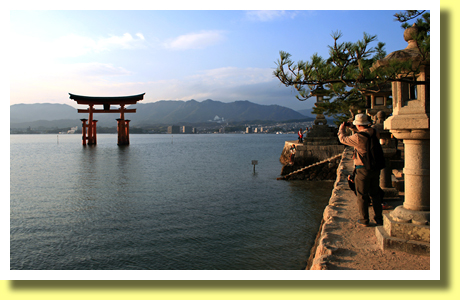
Also the famous torii gate ( above ) of Itsuku-shima Jinja shrine floats in the sea at high tide. The torii gate was rebuilt in A.D.1875 and repaired in A.D.1950. The torii gate is one of the designated National Important Cultural Properties of Japan.
|
|
Torii gate at low tide
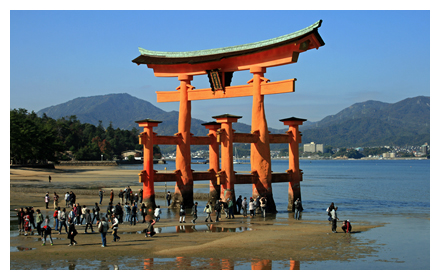
On the contrary, people could walk to and look up at the torii gate at low tide ( above ). Its height is 16.6 meters.
|
|
Shrine at low tide

Also at low tide, people could walk around and look at the shrine ( above ) from the beach. The shrine, standing by the sea, have been damaged by typhoon in A.D.1991, 1999, 2004, 2012 and restored.
|
|
Walking in the shrine

Needless to say, tourists could walk in Itsuku-shima Jinja shrine ( above ) which consists of dozens of buildings connected by cloisters. Six of the buildings of the shrine are designated National Treasures of Japan and more than a dozen are designated National Important Cultural Properties of Japan.
|
|
Sori-bashi ( Chokushi-bashi )

Members of the Imperial Family had visited Itsuku-shima Jinja shrine such as the Cloistered Emperor Go-shirakawa in A.D.1174 and the Retired Emperor Takakura in A.D.1180. Also the Imperial Household had sent their messengers to the shrine. There remain Sori-bashi ( or Chokushi-bashi - above ), a bridge for Chokushi ( imperial messengers ) in the shrine.
The bridge, one of designated National Important Cultural Properties of Japan, was reconstructed in A.D.1557 by Motonari Mori, one of powerful warlords at the time.
|
|
Homotsukan ( Treasure Museum )
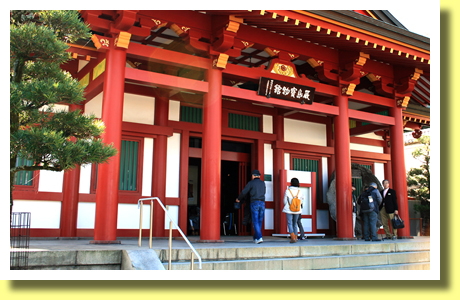
There is Homotsukan ( Treasure Museum - above ) located near Itsuku-shima Jinja shrine, which houses more than 4,000 artifacts, which have been dedicated by many people since the shrine was founded, including swords, armour, attire, pictures and the sutras.
Among the artifacts housed in Homotsukan, more than 250 items are the designated National Treasures of Japan or designated National Important Cultural Properties of Japan, such as the sutras dedicated by Kiyomori Taira and his family in A.D.1164.
|
|
Messengers of Gods
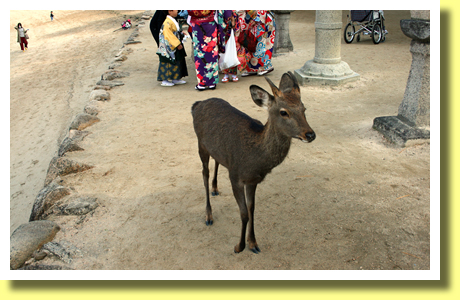
Tourists, walking around the shrine, would not see an Imperial messenger but could see a messenger of the gods ( above ). Deers are considered messengers of the gods. They walk around the shrine as tourists do.
|
|
Goju-no-to ( Five-storied Pagoda )

There is a small hill overlooking Itsuku-shima Jinja. On the top of the hill stands Goju-no-to ( Five-storied Pagoda - above right ), which was built in A.D.1407 and renovated in A.D.1533. Goju-no-to is one of the designated National Important Cultural Properties of Japan.
|
|
Senjo-kaku

Senjo-kaku ( above ), located next to Goju-no-to pagoda, was built in A.D.1587 by Hideyoshi Toyotomi, who built a large castle in Osaka in A.D.1585 and unified Japan in A.D.1590. However he died in A.D.1598 and Senjo-kaku has never been completed.
"Senjo" in Japanese means "one thousand of tatami mats" while "kaku" does "hall". So "Senjo-kaku" means "hall as big as one thousand of tatami mats" though Senjo-kaku is as big as 857 tatami mats actually.
|
|
Shamoji
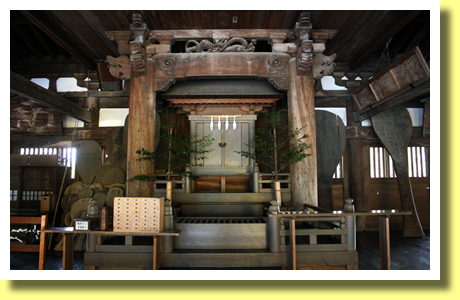
Miya-jima is a famous for production of shamoji ( rice paddles used to serve cooked rice ). Tourists would see giant shamoji ( above ) beside the altar in Senjo-kaku. The giant shamoj were dedicated by those who prayed for victories. Shamoji ( not giant but small ) is now popular among tourists as a souvenir from Miya-jima.
|
|
Age-momiji-manju

Also momiji-manju, steamed bun shaped like a maple leaf and filled with bean paste, is a famous souvenir from Miya-jima. Some souvenir shops serve Age-momiji-manju ( deep-fried momiji-manju - above ), which is a local specialty in the island.
|
|
Anago-meshi
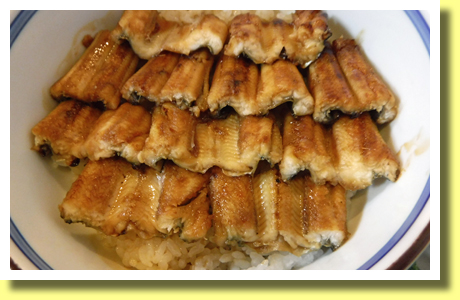
Miya-jima is also famous for Anago-meshi ( above ), which is local specialty in the island as well as in Himeji. Anago-meshi is a bowl of rice topped with broiled Anago ( conger eel ) seasoned with soy sauce,
|
|
Kaki ( oysters )
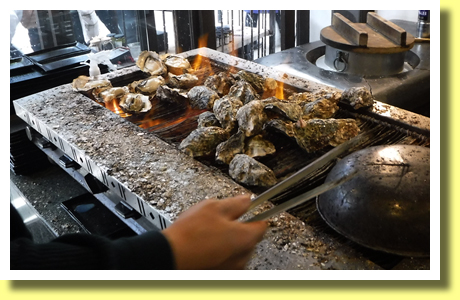
In Miya-jima, lots of Kaki ( oysters ) are cultivated. So tourists could easily find restaurants which serve Kaki dishes such as Yaki-Gaki ( oysters charbroiled in the shell - above ).
|
|
Kaki-meshi ( cooked oysters on rice )
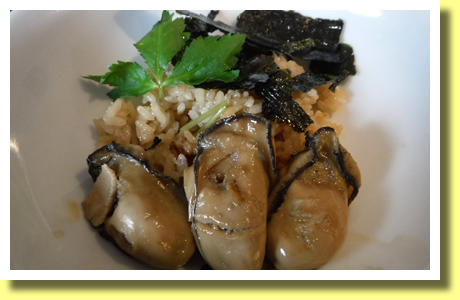
Some restaurants in Miya-jima serve various kinds of Kaki dishes including Kaki-meshi ( cooked oysters on rice - above ), Nama-Gaki ( raw oysters ), Kaki-fry ( deep-fried oysters ), oysters in oil and so on. Miya-jima could be one of the best places to enjoy eating Kaki oysters in Japan. Kaki is one of the most popular seafoods in Miya-jima.
|
Copyright (c) 2021 Achi-Kochi Zanmai Co., Ltd.
|